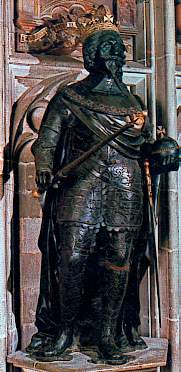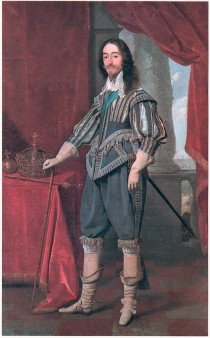The latter years of the reign of King James VI and I had seen the rise of the Arminian influence in the Church especially with the appointment of such men as Richard Neile, Lancelot Andrewes and William Laud to the episcopate. The Arminians saw the need for the restoration of the catholic ideals of the Church of England, ideals which were becoming swamped by the dominance of Calvinist theology and thought which so influenced the Church in the last years of Queen Elizabeth’s reign and the early years of King James.
S.Charles was an avowed Arminian who, heavily influenced by Andrewes and, in particular, Laud, set about restoring the Church of England towards a more catholic sacramental and liturgical life. Like his father before him, King Charles was also a passionate believer in the doctrine of the Divine Right of Kings, a doctrine which he recognised as best upheld by the High Church party in the Church of England.
With the solid support of William Laud, who was appointed by S.Charles as Archbishop of Canterbury in 1633, Arminians were promoted and became the most influential party in the Church. Indeed church affairs in the 1630’s were dominated by S.Charles and Laud. Laud became a hate-figure for the Calvinist faction who saw that Laud and the King were set on dismantling the Calvinist aspects of the Church. Whilst keen to restore the catholicity of the Church, Laud was not a Romanist and placed a special emphasis on the correct use of the Book of Common Prayer which had become almost unrecognisable in many dioceses. He also placed a restraint on preaching, believing it to be subordinate to prayer and the sacraments in public worship and that this would correct what he saw as an imbalance in favour of preaching. As can be expected, this provoked an outcry from the still sizable Calvinist contingent in the Church.

This image of S.Charles was set up in 1640 and inserted into the choir screen of Winchester Cathedral by Inigo Jones. The sculptor was Hubert Le Sueur. During the great Rebellion the image was hidden in the isle of Wight and restored to the Cathedral in 1660
The Holy Eucharist was once again seen as the principal action of the Church rather than the sermon. The doctrine of the Real Presence at the Communion was once again taught in the universities. Vestments began to be worn again. Candles were lit upon altars and a greater emphasis was placed on the externals of worship including the use of music. In particular altars were restored in church buildings, replacing the communion tables which had in turn taken the place of the old stone altars during the iconoclasm of the protestant reformation.
S.Charles wholeheartedly supported Laud and his fellow Arminians in their efforts. It must not be thought that the King supported them solely from a political aspect. Whilst it is true that the High Churchmen were much more supportive of the role of the King as the anointed monarch than the ultra-puritan party, they were also unparalleled in their personal piety and devotional life. The ‘Caroline Divines’, as they have come to be known, left a rich legacy of spiritual writings such as the sermons of Lancelot Andrewes and The Country Parson by George Herbert. Religious Community life was re-established by Nicholas Ferrar at Little Gidding, later immortalised by T.S. Eliot. Their influence sustained the Church through the dark days of the Commonwealth and were recognised in later generations as a ‘golden age’ of Anglicanism. All of this was supported and fostered by S.Charles himself, whose own personal piety was widely remarked on in his own time. This can be seen in his book Eikon Basilke and in many contemporary prints and etchings.
With the loss of the Civil War and the beheading of Laud at the orders of parliament, S.Charles was left as a prisoner of the parliamentarian and puritans. It is now widely recognised that he was offered his throne if he would renounce episcopacy and the Prayer Book and embrace Presbyterianism. This he refused and so found himself facing death. This took place on 30th of January 1649. He was attended solely by Bishop William Juxon who was to succeed Laud as Archbishop of Canterbury at the Restoration of the monarchy in 1660.
Unlike any monarch since, S.Charles attempted to foster his own vision of the Church’s life. This was due to a sincere religious conviction that the Church of England was part of the Catholic and Apostolic Church and that it needed to be restored to that position and, as God’s anointed and divinely appointed King, he had to take the lead. Ultimately it was to cost him his life whilst saving the Church.





